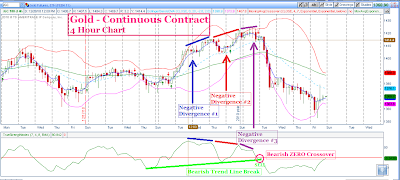An Exquisite Recipe (for a Price Disaster)
Sunday, January 9, 2011
An Exquisite Recipe (for a Price Disaster)
*
Honestly, neither of us saw the Tuesday bear raid coming and our mining positions were flooded in a sea of red for the rest of the week. Perhaps yours were as well.
*
With noticeable disdain for the alleged perpetrators, my friend commented that it is really too bad this kind of manipulation is allowed to take place in the free markets, as lots of small investors are literally blind sided and ripped off when “da boyz” decide to “take down” the market.
*
And he particularly lamented that there was simply no way to know when they would strike.
*
This last comment struck me as interesting as I suspected this was not necessarily true. We decided to look at the gold continuous futures contract and see what the True Strength Index (TSI) indicator could tell us.
 |
| First Chart – Click on to ENLARGE |
*
I was not too surprised with what we found but my friend was rather stunned – particularly after I explained what the chart said.
*
If you would like to learn how to anticipate future bear attacks, I encourage you to continue reading as I am going to show you an exquisite recipe for preparing a price disaster.
*
Successful bear raids are no accident. They are carefully executed when the market’s underlying momentum is prepared to a degree of extreme vulnerability. I hope my effort to explain the following will shed new light for you on the True Strength Index indicator techniques available to you for the anticipation of these powerful selling phenomenon.
*
Let’s begin with a quick look at this first 4 hour chart of the Gold continuous chart contract (/GC) for the action of the past week. I have simply added my usual True Strength Index setting of (7,4) below price, and highlighted the price disaster that began on Tuesday with a red rectangle. I made this chart using the software available at ThinkorSwim.
*
I have permanently placed a page on my website that details the 6 Buy/Sell techniques using the True Strength Index (TSI) indicator that you may reference whenever desired. On the sell side, one of the techniques is the recognition of a negative divergence.
*
A negative divergence occurs when price continues to make a higher high, while momentum (TSI indicator) diverges by making a lower high. Normally, a negative divergence will cause price to correct downward. In effect, price has moved higher without a correspondingly stronger measurement in the TSI momentum indicator, and will need to be corrected.
 |
| Second Chart – Click on to ENLARGE |
*
Our second chart shows that indeed price corrected immediately after the first negative divergence. But incredibly, price then continued to make a new high and a second negative divergence. This alone is fairly unusual – two negative divergences in a row. Price should have certainly gone into a corrective phase but instead, price went higher yet and made a third consecutive negative divergence.
*
At this point, price disaster was virtually assured. Whether “da boyz” get the credit for pushing price up like this when it should have been correcting, I have no idea. But once the heavy selling started it was clear that there would be a vicious outcome.
 |
| Third Chart – Click on the ENLARGE |
*
A couple of the other Sell techniques of the TSI indicator are the trend line break (green line) and the ZERO crossover (hot pink circle). As seen in this third chart, the TSI faithfully sounded these sirens immediately for all who knew how to listen and who were watching the chart at the right time – SELL!
*
Unfortunately for me, I was not watching this chart at the right time and my positions were clobbered.
 |
| Fourth Chart – Click on to ENLARGE |
But I was keenly tuned in to see when the “all clear” siren would be sounded and though it took a few days, I knew it when I saw it.
*
Early Friday morning a couple of the bullish TSI Buy signals appeared to signal the end of the bear raid. As seen on this fourth chart, a bullish positive divergence (orange line) was created when the TSI failed to make a lower low as price made a lower low, and secondly, as price began to rise a bullish trend line break (light blue line) occurred. And once again, the True Strength Index indicator absolutely nailed the bottom of this painful sell-off and gave the Buy signals at the most opportune time.
*
To put it all together, negative divergences between rising price and the underlying TSI indicator call for a downward direction in price. More so after two consecutive negative divergences. And most urgently following three.
*
Trend line breaks of the TSI indicator are sell signals when the indicator is falling and buy signals when rising. The Zero line crossover is bullish when reached from below zero and bearish when the crossed from above.
*
I hope this article will help you in your future trading decisions.
*
Wishing you a profitable week,
*
John Townsend
tsiTrader@gmail.com




